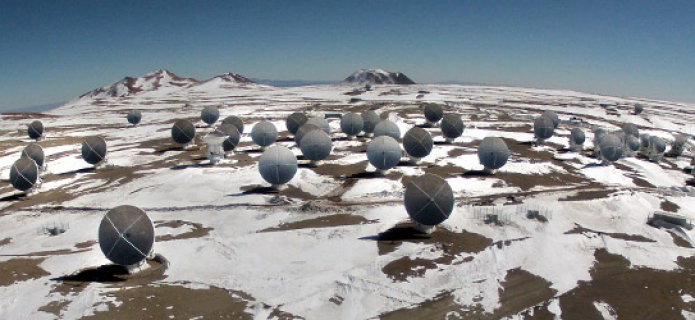First Aerial Pictures from ALMA in Operations
29 July, 2013 / Read time: 3 minutes
The full dimensions of the ALMA Observatory were revealed by these astonishing images of the antenna array surrounded by snow at the Chajnantor Plateau, recently captured with a camera mounted on a hexacopter.
The flight, which is being registered as a Guinness World Record for multi-rotor aircraft at high altitude, was achieved thanks to the aircraft’s carbon fiber platform with six remotely controlled propellers. The security of the antennas was under control, even if the hexacopter was very light (1,8 kilos) and there was wind of around 15-30 k/h. This is because it has a GPS system that makes it return and land at the same place of departure, in case it loses the radio signal.
"Until the day we arrived at the ALMA site there was no record of such a device flying so high. Due to the low atmospheric pressure, propeller resistance in the air gets reduced, preventing them from elevating", states photographer Ariel Marinkovic, X-cam member who led the experience.
The only solution was to decrease the hexacopter’s weight as much as possible. For that purpose, its frame was taken away, including its landing gear, a special structure was designed to let it take off by GPS, and a little camera of 200 grams was chosen, reducing its total weight by 1.2 kilos.
But there was another challenge: the freezing temperatures (around 3°C- at 5,000 meters where the ALMA antennas are located) could lead the hexacopter to lose up to 70% of its capacity. In order to avoid this, a coat made out of thermal fabric and aluminium surrounded its batteries.
"It was a real gamble: the hexacopter was designed to fly 4,525 meters lower than the altitude of the ALMA site. Calculation programs used to fabricate this equipment assured us that it wouldn’t be possible to take off, and so said model aeroplane followers worldwide through their blogs", recalled Marinkovic. Nonetheless, nature pushed him to try: "in a previous journey to Tatio geysers, 4,200 masl, I saw seagulls and I thought that a bird wouldn’t fly in a place where it needs to spend 90% of its energy just to find a different dish".
That reasoning turned out to be right and, consequently, the first aerial images of ALMA operating, were successfully taken, impressing everybody that saw them.
This made for an experience that recalled the origin of Chajnantor’s name, which for the Atacemeño people –the original inhabitants of the region- meant "Place of Departure".
Links
More Information
The Atacama Large Millimeter/submillimeter Array (ALMA), an international astronomy facility, is a partnership of Europe, North America and East Asia in cooperation with the Republic of Chile. ALMA is funded in Europe by the European Southern Observatory (ESO), in North America by the U.S. National Science Foundation (NSF) in cooperation with the National Research Council of Canada (NRC) and the National Science Council of Taiwan (NSC) and in East Asia by the National Institutes of Natural Sciences (NINS) of Japan in cooperation with the Academia Sinica (AS) in Taiwan. ALMA construction and operations are led on behalf of Europe by ESO, on behalf of North America by the National Radio Astronomy Observatory (NRAO), which is managed by Associated Universities, Inc. (AUI) and on behalf of East Asia by the National Astronomical Observatory of Japan (NAOJ). The Joint ALMA Observatory (JAO) provides the unified leadership and management of the construction, commissioning and operation of ALMA.
Contact:
Valeria Foncea
Education and Public Outreach Officer
Joint ALMA Observatory
Santiago, Chile
Tel: +56 2 2467 6258
Cell: +56 9 7587 1963
E-mail: [email protected]
